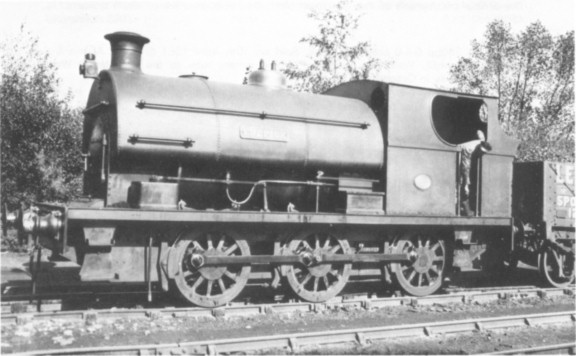
| THE INDUSTRIAL RAILWAY RECORD |
© APRIL 1974 |
PECKETT'S IN RETROSPECT
R.A. WHEELER
The passing of Mr Wilfred Thomas Peckett on 25th March 1972 seems to have escaped notice in our columns, and was a sad reminder that the last member of the family to take an active part in the well known firm of Peckett & Sons Ltd had gone.
As a lifelong enthusiast for industrial locos the attractions of Peckett's locos and those of their predecessors, Fox Walker & Co, were early apparent to me, possibly because of the artistic curves incorporated in the designs, and the lavish display of brass and copper work which they invariably had. Hence this was one of the first makers' lists to claim my attention, but progress was slow, and it was uphill work, so a direct approach seemed necessary.
I have visited Peckett's Works on two occasions, the first being as long ago as Friday, 10th June 1927. At that time, of course, I was a comparatively young man, and the purpose of my visit was to see if I could persuade the firm to give me some official help in completing my list, then woefully incomplete. Greatly daring, I had written to them, asking if I could call at their Works, and mentioning that I should be visiting the Avonside Engine Co Ltd on the same day, this being an attempt to twist their arm! These tactics proved successful, as I received a reply indicating that they would be pleased to see me, and suggesting that I should visit Avonside's first, as the trams ran out there, and it would not take me long to walk across to their Works afterwards!
Accordingly, I got to Peckett's premises early on the afternoon of the day indicated. On arrival I was surprised and delighted to see immediately opposite in the yard of the East Bristol Collieries Ltd a fine example of a Fox Walker standard 0‑6‑0 saddle tank with outside cylinders, this being MAY. Watched by curious colliery workers, a hasty inspection of MAY was duly made, with the object of ascertaining the works number but, in accordance with Fox Walker practice, this was not shown on the works plate, which was dated 1875. Even a close study of the engine's valve gear did not reveal the works number, though I have since discovered that it was 286.

COPPICE (Peckett 1732 of 1927) was one of the locomotives seen by the author on the occasion of his first Peckett visit. He was later able to photograph her in use at Shipley Collieries Ltd, Derbyshire, on 28th September 1934. (R.A. Wheeler)
This little interlude being completed, I duly announced my arrival at Peckett's reception office, and was introduced to Mr Thomas Peckett, who lost no time in trying to get me to say what was going on at Avonside's! Actually, there had not been a great deal to see there, the most interesting item which was pointed out to me being the frame plates just cut for a 4‑8‑2 tank destined for South Africa. This must have been Avonside 2009 of 1927 for Union Steel Corporation of South Africa Ltd. Realising that I was being "pumped", I thought it would be wiser to be discreet about what I had seen. However, as it seemed to me that it would soon be common knowledge that Avonside's had the contract for this big loco, I casually mentioned the fact to him. He appeared to be quite astonished at this information and, waving a file of papers at me, insisted that I must have been mistaken as he was still negotiating with the Corporation regarding the contract. Be that as it may, I felt obliged to inform Mr Peckett that I had seen with my own eyes the frame plates for this engine lying on the works floor at Avonside's, which hard fact he was obliged to accept with as good a grace as possible!
Having got into his stride, so to speak, Mr Peckett then proceeded to tear the Avonside Engine Company to shreds, and if one accepted all he said then it was clear that they were not nice people to know! He told me that Edwin Walker left Fox, Walker & Co, about 1878, and took over the Avonside patterns and drawings. Despite having equipped adjoining works in Bristol in an attempt to re‑establish the firm, he failed two or three times, and it was only after the Company was reorganised and had concentrated on industrial types that he was able to get things going again. Mr Peckett maintained that by doing this Walker had constituted an entirely new firm, and therefore had no right to style it as the Avonside Engine Company or to continue that firm's series of works numbers, which gave an entirely false impression of its output and standing. Of course, at that time I knew nothing of Peckett's practice of leaving many blanks in their own lists of works numbers, so an opportunity of shooting him down was lost!
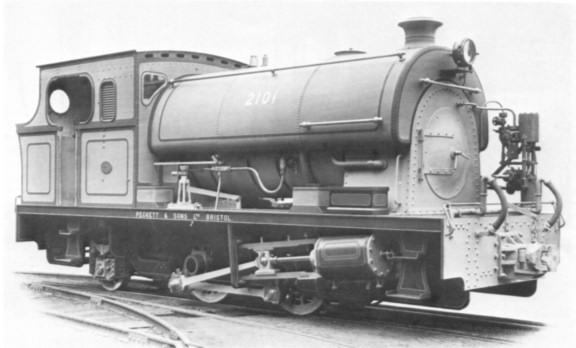
Peckett 2101 of 1949 - described in the text - was a 3ft 6in gauge engine built for the Rhodesian Iron and Steel Company, Bulawayo, Southern Rhodesia, and had 14in x 22in cylinders. (IRS Collection)
Feeling that Avonside's were not as black as they were painted, I ventured to point out that they had only recently built six 0‑4‑0 side tanks for the Great Western Railway (GWR 1101-1106), but this only produced the retort that Peckett's were not keen on this sort of contract, involving as it did inspectors and other types hanging about the Works, and generally getting in the way. Mr Peckett then went on to say that if one of their standard types was not acceptable, then usually they preferred not to quote as they could not afford the Drawing Office costs in getting out a special design only to find that the order did not come their way. This argument seemed reasonable at the time, but as we now know departures were made from time to time, as witness the very interesting 2ft 6in gauge 0‑6‑2 side tanks for the Anglo-Persian Oil Co Ltd, of which three were constructed, the first soon after my visit, to mention only one case.
As it was evident that my interview was drawing to a close, I raised the question of what chance I had of getting some help from official records for the completion of my list of works numbers, but this was brushed aside, and the best I could get was a vague assurance that they might be able to help out on some of my queries if I cared to send them in.
Thomas Peckett then introduced me to his brother, whose Christian name I cannot now remember, but I think it must have been Frank. This gentleman appeared to be responsible for the technical side of things. He took me on an exhaustive tour of the Works, and was only too pleased to answer my questions. According to my notes, several locos were to be seen, but most of these were in a dismantled state, and without works plates. Amongst these was COPPICE (Peckett 1732j, an inside cylinder 0‑6‑0 saddle tank for Shipley Collieries Ltd, which was just being finished off. Some of the engines under repair had been built by other makers, there being two 0‑4‑0 saddle tanks in this category; a Manning Wardle (which Mr. Peckett condescendingly remarked was really quite a good design!) and a Hawthorn Leslie.
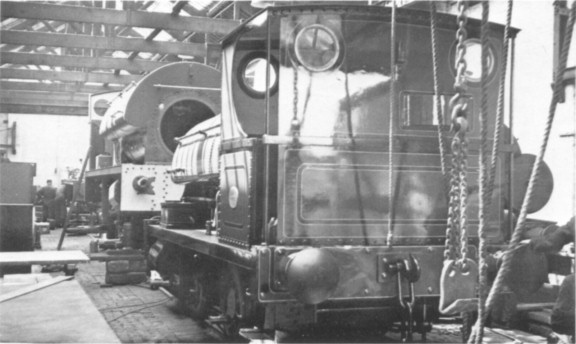
The interior of Peckett's works on 13th June 1955. Peckett 2156, an outside cylinder 0‑4‑0 saddle tank under construction for Cadbury Brothers Ltd, Bournville, is the locomotive on blocks to the rear of the photograph. The engine nearest the camera is another outside cylinder 0‑4‑0 saddle tank, Peckett 917 of 1902, in for repair from Albright & Wilson Ltd of Oldbury. (D.L Chatfield)
Thus ended my first attempt to gain access to the official Peckett records, and although it could hardly be termed a success it had been an interesting experience. My enthusiasm for the firm's products continued unabated over the years, and thanks to the help of others of similar interests, and the ever increasing amount of information becoming available through clubs and societies, to say nothing of visits to as many industrial lines as possible, much progress was made. However, it was not enough, and by 1950 it was obvious that I was still a long way from completion, especially in the earlier years. Also, with the increasing number of diesels being brought in for industrial purposes, it seemed to me that the writing was on the wall and I began to fear that some of the smaller loco building firms would be driven out of business. So I decided to have another go, and wrote to the firm mentioning my 1927 visit, and asking if I might make a further visit. Permission was readily forthcoming, and so on 13th July 1950 I duly presented myself for the second time at the Atlas Works.
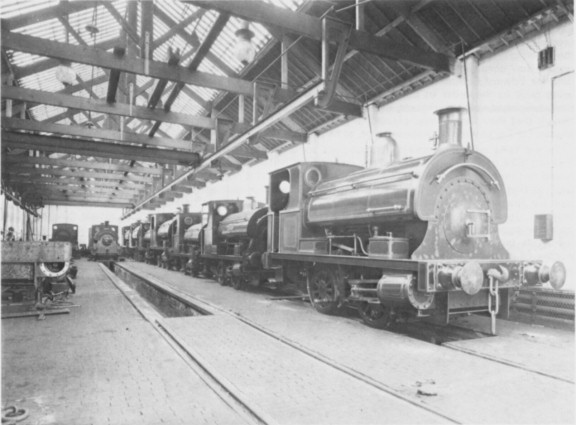
A view in Peckett's finishing shop about 1902. The locomotives include representatives of classes W4, R1 and M4. (IRS Collection)
Time brings changes, and the first thing I noticed on arrival was that the East Bristol Collieries opposite, with the delightful Fox Walker saddle tank, had gone. This, I was told later in the day, had raised problems for Peckett, who had been using the Colliery Company's connection with the old Midland line some distance away, as when the colliery closed, they were obliged to re‑sleeper the track. In due course I was received by Mr Wilfred Peckett, and some interesting talk on old times followed. I asked if I could have a look at their locomotive list, and he immediately produced the register, leaving me to settle down and make such extracts from it as I wanted. On examining this, the first thing that hit me was that there were large numbers of blanks in it, usually in blocks of three or four. No wonder I had so many holes in my own list! I asked Mr Peckett why they did this. All I got in reply was an evasive smile, but he did volunteer the information that they had decided to drop the practice in future.
There followed a tour of the Works, and engines seen were NANCY (Peckett 1067 of 1905), an inside cylinder 0‑6‑0 saddle tank which was being used as Works shunter, and Peckett 1948 of 1938, a standard gauge 0‑4‑0 saddle tank in for repair from Parkhouse Collieries Ltd. Tucked away in an odd corner was Peckett 2105, a cut down standard gauge outside cylinder 0‑4‑0 saddle tank, one of three intended for the Electricity Works at Waddon Marsh, Croydon, but sent back because it had been delivered before it was needed. Mr Peckett was rather sarcastic about this, and told me that when these engines were being built, the Electricity Board had been on at them almost daily, asking for reports as to when the locos would be ready! New construction comprised works number 2120, a standard gauge outside cylinder 0‑4‑0 saddle tank for Edward Collins & Sons Ltd; and 2121‑22, outside cylinder 0‑6‑0 saddle tanks for 4ft 811/16in gauge being built to the order of Egyptian Engineering Stores, for use at a sugar refinery. All these locos were almost finished, and as regards 2120, which was being sent to Scotland, Mr Peckett made the jocular remark that they were always pleased to get in on what was normally Andrew Barclay territory! The two engines for Egypt were of unusual gauge, as he pointed out.
In my talks with Mr Peckett, I mentioned some of the special designs they had done. He referred to Peckett 1824 of 1931, the 0‑8‑0 tender engine for Christmas Island Phosphate Co Ltd and said that they would not normally have quoted for a job of this kind, had it not been for the fact that the Works was very slack at that time. He added that they lost money over the contract. He also mentioned the 0‑4‑2 saddle tank for Rhodesia (Peckett 2101) of which he gave me one of their official photos, and pointed out that in order to clear a feed pump mounted on the running plate it had been necessary to attach the smokebox door the opposite way to normal - an unusual feature. Still on the subject of special designs, the three 0‑4‑0 side tanks for Mason & Barry in Portugal (2125‑27 of 1952), built some time after my visit, are worthy of mention as Mr F.G. Palmer, their Manager, told me that he specially asked for side tanks to be incorporated because he thought that saddle tanks produced too high a centre of gravity.
Some of the constructural features of Peckett locos are of interest; for example, the slavish devotion to "H" section wheel spokes, and the long standing adherence to spring balanced safety valves, except in the case of certain special designs. I asked Mr Peckett when they changed to "Pop" valves, and he said he thought this would be about 1912.
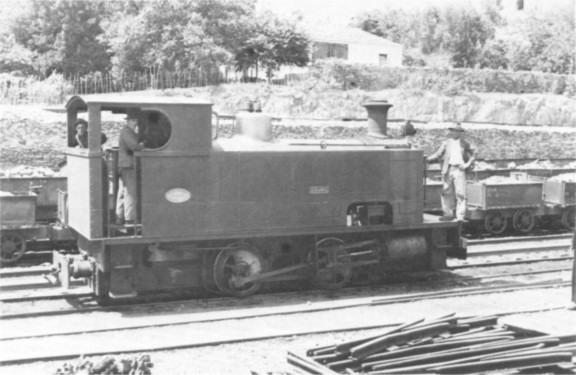
One of the unusual 0‑4‑0 side tanks supplied to Mason & Barry Ltd, Portugal, DOURO (Peckett 2125 of 1952) is seen here on 3rd June 1958 at Sao Domingos. (R.A. Wheeler)
As we now know, in the declining years the firm made some attempt to get into the diesel market, but with little success, and so closure was inevitable, the business being purchased in 1961 by the Reed Crane & Hoist Co Ltd according to Miss Joyce Peckett Wyllie in a letter to me dated 8th July 1962. An ex‑Peckett employee I spoke with recently said some large orders for spare parts were received after the take over, but by then the Reed Crane & Hoist Co Ltd had gone into liquidation!
It is sad to think that there will be no more Pecketts.